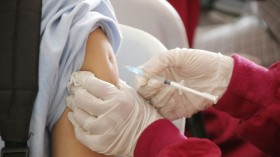As if you weren't already skeeved out by NYC's subways, now new research shows that they are infested with traces of the Bubonic plague, or the Black Death that ravaged 14th-century Europe and killed millions.
That's really not so surprising considering that these rat-ridden systems bring millions of people a day to where they need to go. Most of the microbes that have called NYC's subways home are harmless to humans, however, researchers at the Weill Cornell Medical College swabbed more than 400 subway stations and found that some of them can cause disease and are resistant to drugs.
The researchers also collected DNA fragments that are associated with the Bubonic plague, anthrax, and mystery DNA.
The aim of the study, published in the journal Cell Systems, was to create a pathogen map, or "PathoMap," of the city that includes the subway. This could help healthcare professionals with more accurate disease surveillance and long-term health management for the city, researchers say.
"PathoMap also establishes the first baseline data for an entire city, revealing that low-levels of pathogens are typical of this environment," Dr. Christopher Mason, the study's senior investigator, said in a press release. "While this is expected in rural environments, we've never seen these levels before in cities. We can now monitor for changes and potential threats to this balanced microbial ecosystem."
To assess NYC's subway microbes, Mason and his colleagues took bacteria samples from various locations and objects in the subway system, such as trash bins, ticket kiosks, benches, railings and more. The team also collected samples from the inside of trains, including seats, doors, poles and handrails.
While it's a relief to know that the majority of the microbes they found are not dangerous to humans, 12 percent of them could still cause diseases. These diseases were present in 27 percent of the total fragments collected during the study.
"Our data show evidence that most bacteria in these densely populated, highly trafficked transit areas are neutral to human health, and much of it is commonly found on the skin or in the gastrointestinal tract," Mason said. "These bacteria may even be helpful, since they can out-compete any dangerous bacteria."
Two samples were found to have DNA fragments of anthrax and three samples had a plasmid associated with the Bubonic plague.
But don't freak out yet. Experiments showed that these fragments aren't still alive. If the plague had been discovered, it would truly be a breakthrough considering a single case hasn't been reported in NYC since 2013 - the same year the PathoMap project began.
And though rats - possible carriers of Bubonic plague - have been known to frequent the subway system, researchers have never found an infected rat in the city.
The study also revealed that about 50 percent of the DNA found on the subway's surfaces did not match any known organism.
"Despite finding traces of pathogenic microbes, their presence isn't substantial enough to pose a threat to human health," noted Mason. "The presence of these microbes and the lack of reported medical cases is truly a testament to our body's immune system and our innate ability to continuously adapt to our environment."
So while it appears unlikely that as a NYC commuter you will catch some sort of deadly disease on your way to work, carrying Purell hand sanitizer with you just in case isn't such a bad idea.
For more great nature science stories and general news, please visit our sister site, Headlines and Global News (HNGN).
© 2024 NatureWorldNews.com All rights reserved. Do not reproduce without permission.





